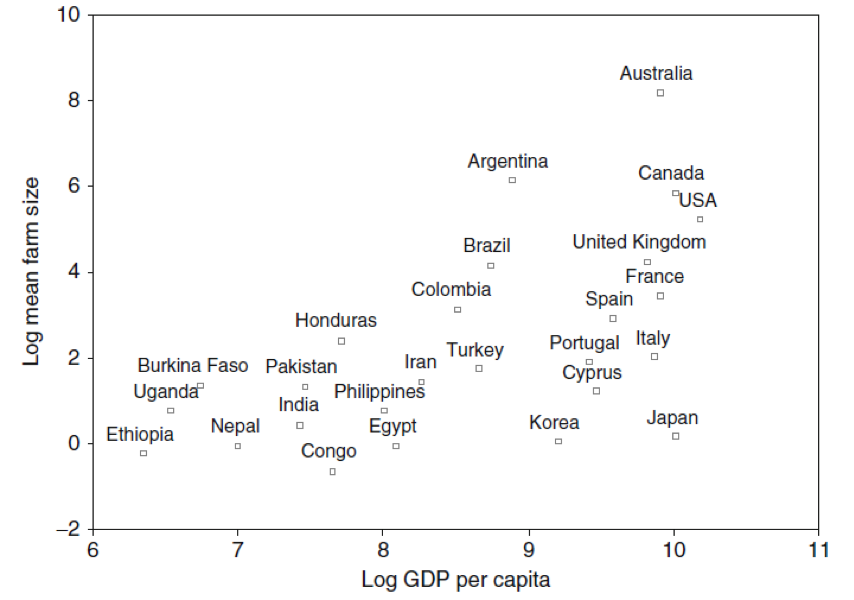The project’s ‘rental’ arm has been the primary method of conducting farmland transactions for farmers and landowners. On the other hand, its ‘sales and purchases’ arm is dysfunctional due to a moratorium on farmland sales that was introduced in 2001. The moratorium was originally intended as a transitional measure that would lastfor 5 years. But since then, it has been extended several times and currently is set to expire on January 1st 2017.
How the Law on Agricultural Land Turnover Would Look Like if Policy Makers in Ukraine Based Their Decisions on Existing Empirical Evidence and International Experience
However, a precondition for lifting the moratorium is the adoption of the “Law of Ukraine on Agricultural Land Turnover”. This law should establish rights and restrictions in the farmland sales market, e.g. restrictions on the access to the market, caps on the size of land ownership, preemptive rights etc. The draft Law must be submitted to the Parliament of Ukraine by March 1st, 2016. There are already a couple of drafts available. In this paper, we present our view on how the Law on Agricultural Land Turnover would look if policy makers in Ukraine based their decisions on existing empirical evidence and international experience.
International experience and empirical evidence on the structure of farmland sales markets
There is a large array of models in the world of how the state interferes with farmland sales markets. There is also a large international economic literature on the consequences of introducing various restrictions on the land market. The literature provides a rather clear suggestion on the most appropriate farmland sales model that is capable of incorporating various peculiarities and circumstances. This suggestion can be summarized in the following way:
- Farmland sales restrictions, including bans, have rarely achieved their desired results. There have been many cases where centralized restrictions on land sales seemed justified, but enforcement challenges created distortions that only worsened the situation. Governments’ measures to improve farmland sales markets all over the globe have either led to higher transaction costs for participants or have driven land transactions to the informal realm, reducing the welfare of all participants. Universal limitations on farmland sales markets are unlikely to be effective, but may lead to the emergence of large bureaucracies that develop a self-interest in maintaining these restrictions.
- Fexible forms of economic incentives (e.g. land tax, fees, and tariffs) are preferable to rigid restrictions. Land tax is one. The most important way in which governments can help to improve the functioning of farmland sales markets is to eliminate distortions; to help reduce transaction costs that would increase the barriers for participation, especially by the poor and smallholders; and to improve the functioning of financial markets. Economic literature implies that the only justifiable interventions are temporary land sales moratoria or limits on accumulating extremely large tracts of land (preventing local monopolies) in situations of rapid transition or emergence of new markets.
- Decentralized approaches are preferable when defining the model and restrictions on the farmland sales market. The market for farmland is primarily local and has its own peculiarities. If transparent mechanisms for decision-making are available and local communities bear the costs of their decisions, they may be given the authority to restrict the transferability of land on their local farmland market. This will help strike a balance between the social and economic issues related to introducing and operating the farmland sales market. The expectation is that with changing economic circumstances and territorial competition, restrictions will be relaxed. Where transparent mechanisms are unlikely to prevail, the preferred policy should be to forgo restrictions.
How policy makers could react or recommendations for Ukraine
Before making general recommendations, there is one remark that needs to be made. In Ukraine, one can often hear that before deciding on the farmland model or restrictions, the Government or general public has to agree on what type of agrarian structure Ukraine should have. The discussion boils down to the choice between favoring either smallholding or large agricultural producers.
Of course, this might be a political decision by Government, but from the economic point of view and from the international experience there is no solid evidence to favor one farm size over the other.
Many papers (but mainly drawing on data from developing countries) documented an inverse relationship between farm size and land productivity. This is mainly because in a land scarce environment smaller farms apply larger amounts of labor per hectare and thus get higher yields per unit of land. On the other hand, farm size is strongly associated with economic growth (see Figure 1). Economic theory also suggests that family farms will typically become larger with economic development (Eastwood et al, 2010). In the EU, , there is also a strong positive relationship between farm incomes and sizes (see). In other words, favoring small farmers over the large ones suggests that agriculture will be better off remaining poor (see).
In the case of Ukraine, a recent study by Deininger et al (2013) shows no relationship between the farm size and productivity of crop production. This study also demonstrates that the farm size matches farm specific productivity shocks (e.g. quality management, access to capital). In other words, farms that are more productive tend to accumulate larger holdings. These findings imply that land policy should not provide a support to any particular structure, but should focus on better transferability of land to a more productive user.
Figure 1. Mean farm size and GDP per capita, selected countries, 1990s

Source: Eastwood et al (2010)
Based on the international experience and on the remark above, the following structure for the farmland sales market (for private land) is suggested for Ukraine:
Delegate the right and responsibility to form the structure of local farmland sales market to local government, preferably at the rayon level. This would delegating the following:
- The decision on when to open up the farmland land sales market;
- The authority to restrict market access t for legal entities, residents of other rayons or regions, foreigners,or to impose other farmland sales restrictions;
- The authority to introduce and extend etransition periods with temporary restrictions;
- The authoirty to establishing land sales taxes rates, fees, and exceptions, etc.
The Farmland market is primarily a local issue. If the local community is involved in decision-making about the farmland sales market, it will help strike a balance between the social and economic considerations of farmland sales market.
The central government should ensure that the mechanisms for making decisions on a local level are transparent and representative. These mechanisms at the rayon level are currently available via rayon councils. However, local authorities and communities must be fully accountable for their decisions. Delegating decisions on land market structure to rayon level is preferable to village level because the capacity of village councils to make independent non-partial decisions is quite poor. However, participation of village communities in rayon council meetings shouldbe strongly encouraged. This approach is in line with the current decentralization reform performed by the Government and President of Ukraine. This could also be achieved via first initiating a pilot sales market for land in a small number of selected rayons by delegating the right for opening up the farmland land market and imposing farmland sales restrictions to the local level, and then extending this experience to other rayons of Ukraine.
There are concerns that local governments are used to the centralized governance and it would be difficult or almost impossible to get used to the new paradigm. Some also argue that by decentralizing, we will just shift corruption to the local level. These two concerns are more a speculation. In response, we would like to argue the following:
- The first concern, we think, underestimates the capacity of local communities to take responsibility, unite and take action. Recent events in Ukraine perfectly demonstrate this. People in Ukraine are willing and struggling to take the responsibility for their own lives, for the environment they are living in. More pragmatically, local governments are already establishing land tax rates and exemptions at local level. Taking yet additional functions of land governance will be in line with the decentralization process.
- Regarding corruption, we would rather expect the opposite effect. The costs of mistakes (deliberately committed or resulting from corruption affairs) would be smaller on a local level, so overall corruption and mistakes’ costs for the entire Ukraine would also be smaller. Moreover, the territorial competition between (at least adjacent) rayons and political accountability in front of local constituency will decrease corruption costs further.
The Central Government can also perform several important functions:
- Establishing a maximum transition period when temporary restrictions on access of foreigners and legal entities, high tax rates and temporary land ceilings might be in effect. We suggest this transition period would be in effect for 3 to 5 years.
- Introduction of (temporary) ceilings on accumulating extremely large tracts of farmland. The central government could establish very high ceilings, while the local governments are allowed to select any specific level below the centrally established level. Apparently, different regions of Ukraine might have their own ideas about the ceilings that would depend on various factors (existing farm structure, quality of soils, land use patterns, traditions, etc.) Thus, it is important to choose the principle that would define such a ceiling for a given region. Ensuring local competition and antimonopoly legislation has to serve as a guidance in making these decisions. The core law of antimonopoly legislation in Ukraine – the Law of Ukraine “On securing economic competition” (Article 13), – defines monopoly situation when the share of a firm on a market exceeds 35%. We recommend to apply this criteria to local (rayon) farmland market, i.e. accumulation of extremely large tracts of farmland (35% of the rayon farmland area) in usage or ownership or both, by physical or legal persons or by related parties (both physical and legal) is prohibited. Local governments will have an opportunity to decide exactly on the figures up to this limit.
- Use of land tax and sales fees to prevent aggressive speculations with agricultural land and to preserve designation of land, instead of rigid restrictions. Measures to struggle the speculation on farmland sales market should be aligned with ones that exist on Ukrainian real estate market. For example, now the Tax Code of Ukraine (article 167) applies a 5% tax for incomes received from selling the real estate that has been in ownership for less than 3 years, beyond 3 years a 0% tax rate is applied. In our case higher tax rates (e.g. 10%) could be applied during a transition period, but after that this tax rate should be decreased to 5%. This scheme would ensure two important things:
- this would allow local government to generate desperately needed additional incomes,
- but more importantly, the tax will exclude the risk of excessive speculations on the market, but will not exclude entirely speculations from the market. Contrary to the common opinion, speculations may play a useful function for Ukraine’s farmland market particularly during the initial stage of market formation (see). They are at least three: i) supply information and discover prices. Information on the farmland plots is notoriously scarce in Ukraine and speculators will help to seek information, act on it and incorporate the information into the price. ii) increase liquidity of the market; that would make investments in farmland and farming more attractive. iii) act as intermediary in land consolidation process.
- Restrict the access to farmland exclusively based on the farmland usage regime. This is related to protected and sanitary zones, special land use regime that is linked to national security and defense, environment protection and vital infrastructural objects. For example, the Government could set up a ban on farmland sales to foreigners within the national border zone.
- Recommendations on the strategic land relations developments and corresponding restriction parameters. For example, stimulating land consolidation, although in principle private market might emerge for performing this function.
- Establishing and maintaining land-monitoring system to reduce informational disadvantage of land market participants and to ensure the transparency of land relations in Ukraine.
Literature used
1.Eastwood, R., Lipton M., and Newell A (2010). Farm Size. In Handbook of Agricultural Economics Volume 4.
2.Deininger, K., Nizalov, D., & Singh, S. (2013). Are mega-farms the future of global agriculture? Exploring the farm size-productivity relationship for large commercial farms in Ukraine (Policy Research No. 6544). World Bank Policy Research Working Paper (Vol. 6544).
Notes
[1] This paper is a short version of analytical working paper “Restrictions on farmland sales markets: a survey of international experience and lessons for Ukraine” developed by the authors in the framework of Project “Capacity Development for Evidence-Based Land & Agricultural Policy Making in Ukraine”
Attention
The authors do not work for, consult to, own shares in or receive funding from any company or organization that would benefit from this article, and have no relevant affiliations





